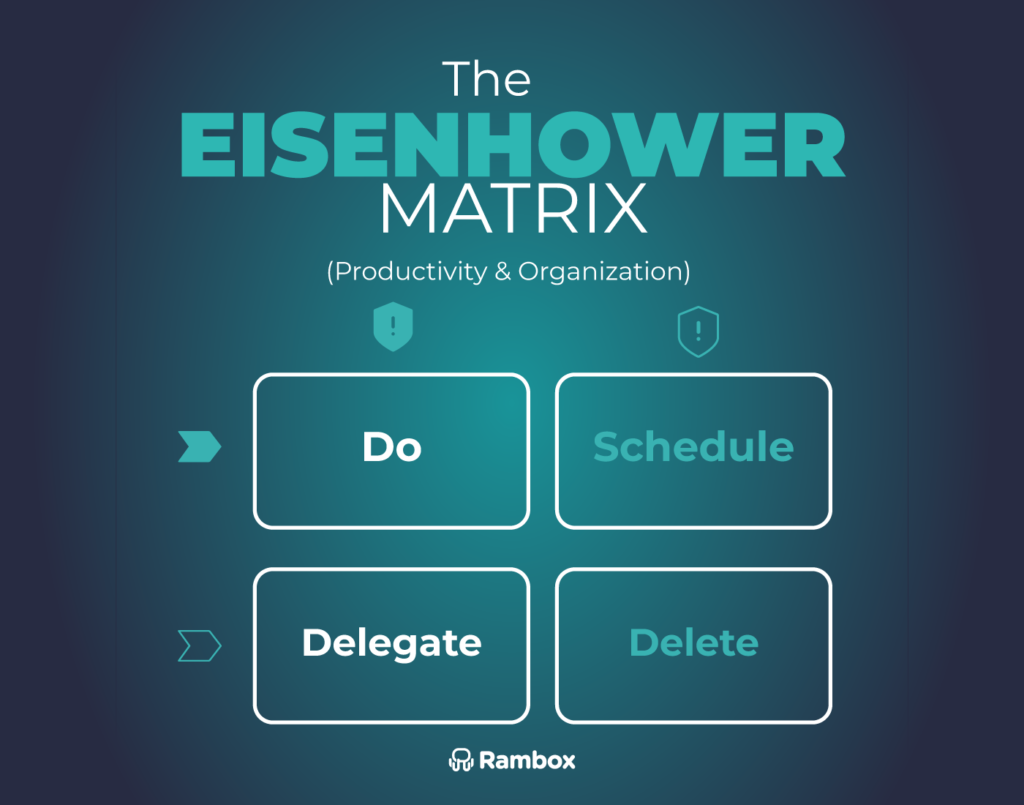Effective time management is essential for productivity and success in today’s fast-paced world. With countless tasks and responsibilities competing for our attention, it’s crucial to have a framework that helps us prioritize and focus on what truly matters. This is where the Eisenhower Matrix comes in.
In this post, we will explore the principles and practical applications of the Eisenhower Matrix. We’ll delve into its four quadrants, each representing a different combination of urgency and importance, and we’ll discuss strategies for handling tasks within each quadrant. Join us as we uncover the fundamentals behind the Eisenhower Matrix, discover real-life examples of its implementation, and explore how you can leverage tools like Rambox to seamlessly integrate this matrix into your daily routine.
Contents
How to differentiate between urgent and important tasks
To effectively apply the Eisenhower Matrix, it’s crucial to understand the distinction between urgent and important tasks. While these terms may seem similar, they carry different meanings and require different levels of attention and prioritization.
Urgent tasks are those that require immediate action or attention. They often have impending deadlines or time-sensitive consequences. Critical tasks demand primary focus, as delaying or neglecting them can lead to adverse outcomes or missed opportunities.
On the other hand, important tasks contribute to our long-term goals, values, and aspirations. They may not have immediate deadlines or pressing time constraints, but they hold significant value in personal growth, professional development, or overall success.
To differentiate between urgent and important tasks, it’s helpful to ask yourself the following questions:
- Is there a deadline associated with this task?
- What are the consequences of failing to complete this task promptly?
- Does this task align with my long-term goals or priorities?
By evaluating tasks based on these criteria, you can gain clarity on their urgency and importance and classify them accordingly within the Eisenhower Matrix. Understanding the distinction between urgent and important tasks is the foundation for effective prioritization and efficient task management.
What is the Eisenhower matrix?
The Eisenhower Matrix is a productivity tool that helps individuals prioritize and manage their tasks effectively. It consists of four quadrants that categorize tasks based on urgency and importance.
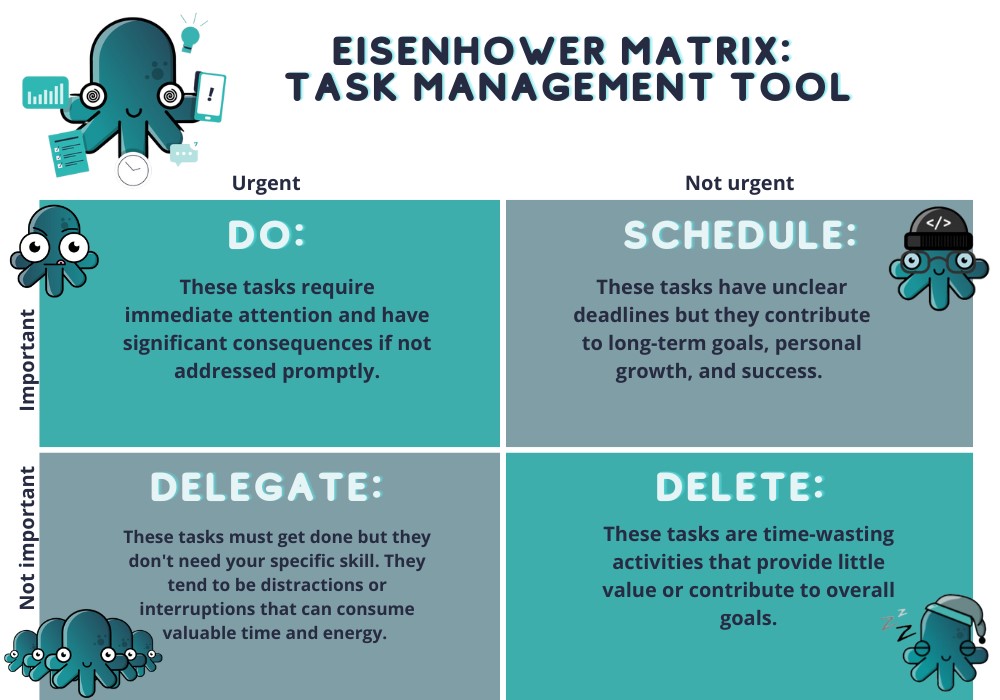
By using the Eisenhower Matrix, individuals can prioritize tasks based on urgency and importance, enabling them to focus on high-priority activities, minimize distractions, and optimize productivity.
Quadrant 1: Urgent and Important
Quadrant 1 of the Eisenhower Matrix is often called the “do” quadrant. It is where tasks that are both urgent and important are placed. When you come across a task on your to-do list that requires immediate attention, carries significant consequences, and directly impacts your long-term goals, it belongs in this quadrant.
Tasks in Quadrant 1 are typically at the forefront of your mind and may be causing you stress. They cannot be ignored or postponed without detrimental effects. These tasks have clear deadlines or time-sensitive elements, and their completion is crucial for maintaining progress and achieving desired outcomes.
The urgency and importance of tasks in Quadrant 1 make them a top priority in your task management. Failing to address them promptly may lead to negative consequences, missed opportunities, or compromised goals.
Quadrant 2: Not Urgent but Important
Quadrant 2 in the Eisenhower Matrix is known as the “schedule” quadrant. This quadrant is where you’ll place tasks that are important for your long-term goals but do not require immediate attention. These tasks significantly impact your success, but they can be scheduled for later completion.
Unlike urgent tasks in Quadrant 1, Quadrant 2 tasks allow for more deliberate planning and allocation of time. Once you’ve addressed the urgent tasks in Quadrant 1, you can focus on the tasks in Quadrant 2. By effectively managing these tasks, you can progress toward your long-term objectives.
To accomplish the tasks in Quadrant 2 efficiently, consider implementing various time management tips and techniques, like the Pomodoro method.
Quadrant 3: Urgent but Not Important
Quadrant 3 within the Eisenhower Matrix serves as the “delegate” quadrant. It is the designated space for tasks that demand immediate attention but hold minimal significance to your long-term goals. These tasks may require prompt completion, but they can be effectively assigned to others, allowing you to prioritize more crucial focus areas.
In Quadrant 3, you’ll encounter tasks that demand your attention but lack a personal attachment or do not need your specific skill set. Leveraging the ability to delegate these tasks to other team members can prove highly efficient in managing your workload while providing your team with opportunities for skill expansion.
Quadrant 4: Not Urgent and Not Important
After reviewing your to-do list and allocating tasks to the first three quadrants, you’ll likely encounter a few remaining tasks. These tasks do not fall under the categories of urgency or importance.
These lingering tasks, characterized as unimportant and lacking urgency, can impede your progress toward achieving your goals. They act as distractions, diverting your attention from more meaningful endeavors. To address these obstacles, designate them to the fourth quadrant of your to-do list, commonly known as the “delete” quadrant.
Pros and Cons of the Eisenhower matrix
As with any productivity tool, the Eisenhower Matrix has its own advantages and considerations. By examining the pros and cons of using this matrix, individuals can better understand its potential benefits and limitations. This analysis enables individuals to decide whether the Eisenhower Matrix is the right approach for their task management needs. Let’s explore the pros and cons of using the Eisenhower Matrix:
| PROS | CONS |
| Efficient task prioritization. | Overemphasis on urgency, neglecting importance. |
| Clear visualization of priorities. | Difficulty in accurately assessing urgency. |
| Improved time management. | Potential for procrastination in Quadrant 2. |
| Enhanced focus on long-term goals. | Reliance on personal judgment. |
| Helps prevent task overload and burnout. | May not be suitable for all types of tasks and work environments. |
| Encourages delegation and collaboration. | May require periodic adjustments and reassessment. |
| Supports better decision-making. | Can be overly rigid if not flexible enough. |
| Provides a structured framework for task management. | Requires consistent and disciplined implementation. |
| Promotes a sense of control and productivity. | May not address unexpected or unpredictable tasks effectively. |
Real-life Examples
The Eisenhower Matrix is a versatile tool that can be applied to various real-life scenarios to improve task management and productivity. Here are a few examples of how the matrix can be utilized:
- Work Projects: When working on a complex project, use the Eisenhower Matrix to prioritize tasks based on their urgency and importance. This helps ensure that critical tasks are addressed promptly while maintaining focus on long-term project goals.
- Daily Planning: Incorporate the matrix into your daily planning routine. Assess the tasks on your to-do list and categorize them into the appropriate quadrants. This allows you to allocate your time and energy effectively, focusing on tasks with the most significant impact.
- Meeting Preparation: Before attending a meeting, evaluate the agenda items using the Eisenhower Matrix. Identify urgent and important tasks, ensuring they receive the necessary attention during the meeting while delegating or eliminating tasks that fall into the other quadrants.
- Time Blocking: Combine the Eisenhower Matrix with time-blocking techniques. Assign dedicated time blocks for each quadrant, allowing you to allocate specific periods for urgent, important, and non-urgent tasks. This approach ensures that important tasks receive the necessary attention and helps avoid being overwhelmed by urgent but less significant tasks.
Remember, the real power of the Eisenhower Matrix lies in its adaptability to different situations. Experiment with its application in various areas of your life to discover the most effective ways it can support your productivity and goal achievement.
Implement the Eisenhower matrix with Rambox
Rambox is a workspace organizer that allows you to unify all the applications you want in one place. It is perfect for those who care about productivity while working with many business and personal applications. With Rambox, you can easily access all your apps from a single interface, and it is also a helpful tool that can assist in implementing and utilizing the Eisenhower Matrix effectively.
Task Categorization
With Rambox Workspaces, you can create as many workspaces as you need, allowing you to group your applications according to different categories, projects, or specific contexts. For example, you could have one workspace dedicated to work and another for your personal applications.
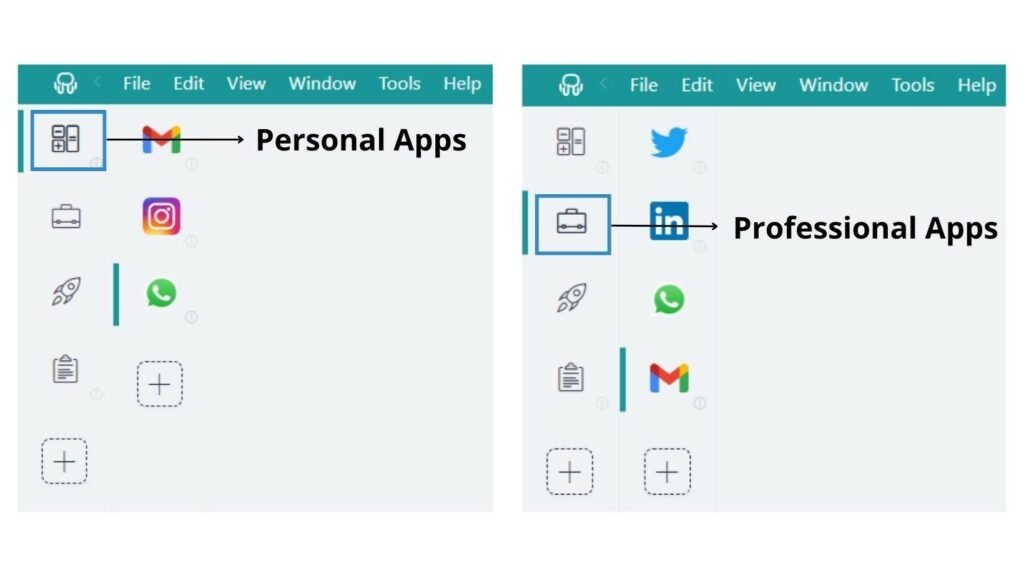
This functionality aligns well with the Eisenhower Matrix’s task categorization and prioritization needs. For example, you can create separate workspaces within Rambox to represent each quadrant of the Eisenhower Matrix. You can have a workspace for Quadrant 1 (Urgent and Important tasks), another for Quadrant 2 (Important but Not Urgent tasks), and so on. This segregation allows you to visually organize your applications and tasks according to their urgency and importance.
By utilizing Rambox Workspaces, you can clearly focus on the tasks and applications associated with each quadrant. When working on tasks in Quadrant 1, you can switch to the dedicated workspace and have all the necessary applications at your fingertips. This separation helps minimize distractions and lets you concentrate on the most critical and urgent tasks.
Notifications and Reminders
In addition to its workspace organization capabilities, Rambox provides a centralized platform for receiving notifications and alerts from all your applications. This functionality further enhances your ability to prioritize tasks and manage your time efficiently.
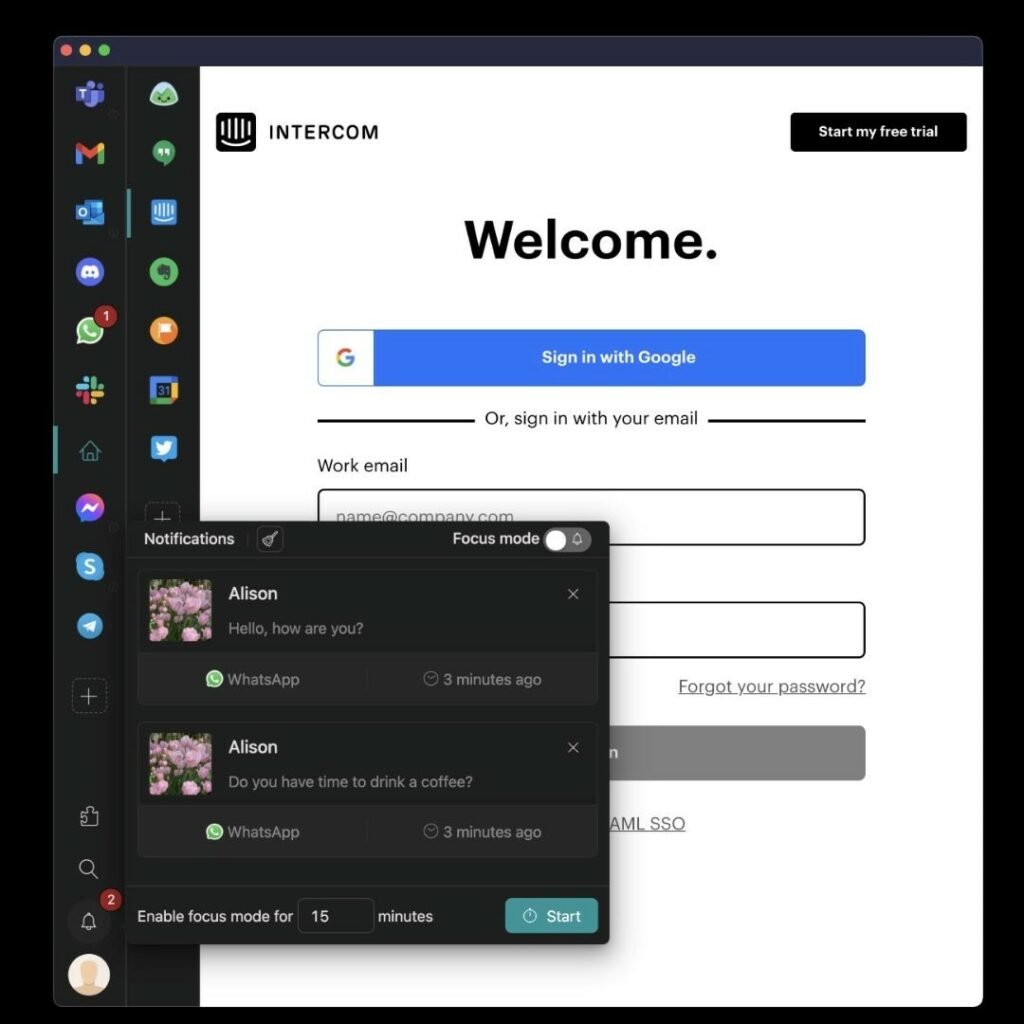
By receiving notifications in Rambox, you can stay informed about essential changes or updates from your applications without constantly switching between different tools or platforms. Whether it’s an email, a chat message, or a task reminder, you can access and respond to notifications on time, ensuring that urgent matters are addressed promptly.
Focus Mode
Another feature of Rambox that can be useful for applying the Eisenhower Matrix is the Focus Mode.
With this mode, you can turn off notifications indefinitely or set a manual time so that nothing disturbs you while you complete your task. This is especially beneficial for implementing the first quadrant of the Eisenhower Matrix.
We know how important concentration is and how easy it is to lose it. The sound of apps or message notifications on the screen can cause us to lose concentration, and sometimes it’s hard to refocus.
When working on those critical and urgent tasks, activate Rambox’s Focus Mode to focus on what you’re doing and forget about notifications that can cause you to lose concentration.

Apps listing
Rambox has more than 700 default applications to add to your taskbar. This includes popular free time management apps like Paymo and Todoist, which can be instrumental in organizing and prioritizing your tasks according to the Eisenhower Matrix. By accessing a comprehensive list of applications, you can choose the ones that align with your specific needs and preferences.
Adding these apps to your workspaces or your apps’ bar in Rambox is very easy. Just follow the steps below:
1. Go to the workspace where you want to add the app. Click on “+ Add an app or workspace.

2. Type the app’s name in the search panel. Remember to set the search filter to “All”.

3. Configure the application settings to your liking.
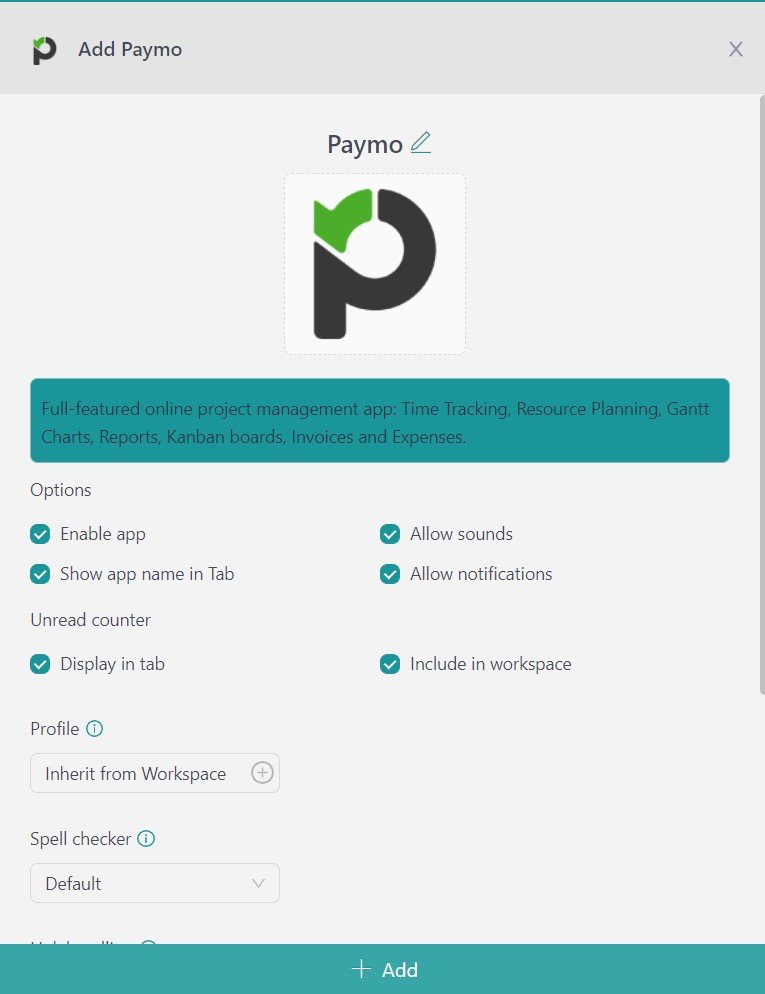
That’s it! The apps have been added to your Rambox’s workspace!
If you are overwhelmed by the number of applications you have to work with, try Rambox for free. All you have to do is download the program, configure it to your liking, and enjoy its functionalities. No cards, no cheating, it’s that simple!
